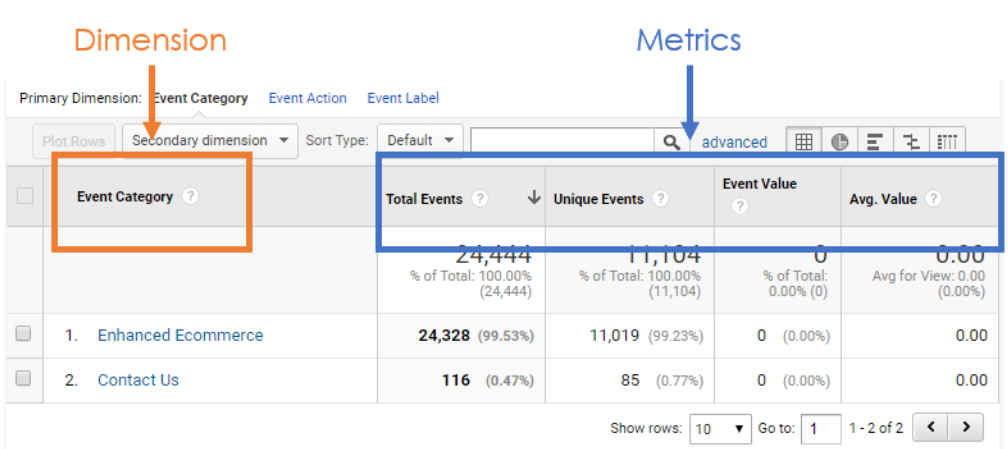Maximizing Search Engine Optimization with Secondary Dimension in Google Analytics
Maximizing Search Engine Optimization with Secondary Dimension in Google Analytics
Blog Article
Maximize Reporting Accuracy With Second Dimension in Google Analytics
Understanding how to optimize reporting accuracy with additional dimensions in Google Analytics can substantially enhance the deepness of understandings derived from data evaluation. By incorporating additional dimensions tactically, marketing professionals can reveal hidden patterns and relationships that may not be promptly obvious when evaluating primary metrics alone.
Comprehending Additional Dimensions in Google Analytics
Additional measurements allow individuals to sector and additionally dissect data past the primary measurement picked. While the main measurement may present the total number of web page views, adding a secondary dimension such as 'source/medium' can give understandings into where the website traffic stemmed from.
Additionally, recognizing additional measurements is important for creating a lot more customized reports customized to particular service goals. By selecting the best mix of key and additional dimensions, experts can discover patterns, trends, and correlations that may otherwise continue to be concealed. This nuanced strategy to data evaluation equips organizations to make enlightened choices based upon a thorough understanding of user actions across numerous measurements.

Just How to Use Additional Measurements
When leveraging secondary dimensions in Google Analytics, the sensible application includes selecting particular data criteria to additional fine-tune insights past the primary dimension's scope. To apply additional measurements effectively, begin by accessing the report or dataset where you wish to dig deeper into the data. Within Google Analytics, locate the main dimension that you are currently assessing. Once identified, click on the dropdown menu labeled "Secondary Dimension." This action will disclose a checklist of additional parameters that can be contributed to your analysis. Choose the additional dimension that straightens with your logical objectives, such as 'Source/Medium,' 'Tool Category,' or 'Place.' By choosing an additional measurement, you can get extra detailed insights into individual actions, demographics, or acquisition channels. Keep in mind that additional measurements aid offer context and granularity to your main measurement data, allowing you to remove more purposeful and actionable understandings from your Google Analytics reports.
Leveraging Additional Measurements for Insights
Making use of second dimensions in Google Analytics enables a much more detailed analysis of information, offering valuable insights past the main dimension's scope. By leveraging secondary measurements, individuals can dive deeper right into the efficiency metrics of their site or application, discovering surprise patterns and trends that might not be right away noticeable when only considering primary dimensions.
One key benefit of making use of secondary dimensions is the capability to sector and filter data much more specifically. This can aid analysts and marketing professionals much better understand the habits of specific individual sectors, such as new site visitors versus returning visitors, or web traffic weblink coming from different geographic places.
Furthermore, secondary dimensions allow customers to compare and comparison various data factors within the same report, providing a much more holistic view of efficiency (Secondary Dimension in Google Analytics). For instance, coupling the primary dimension of landing web pages with secondary dimensions like tools or demographics can reveal which web pages are most effective in engaging individuals on different gadgets or from different market teams.
Basically, leveraging secondary measurements in Google Analytics empowers users to remove richer understandings from their data, resulting in even more informed decision-making and ultimately, boosted efficiency.
Ideal Practices for Second Dimensions
When assessing data in Google Analytics, including additional dimensions properly boosts the depth of Continue understandings originated from the primary metrics. To make one of the most out of secondary measurements, it is vital to adhere to ideal methods that make certain purposeful and precise reporting. To start with, it is essential to select second measurements that line up with the main metric you are evaluating. Choosing pertinent secondary measurements helps in providing context and a more clear understanding of the information being checked out.
Additionally, it is advised to restrict the number of secondary measurements utilized in a single report to stay clear of overwhelming the evaluation with way too much information. Focusing on a couple of crucial additional measurements each time can lead to more focused and workable insights. Furthermore, take into consideration try out various combinations of additional and primary measurements to uncover unique patterns and patterns that might not be obvious when taking a look at the data in seclusion.
Advanced Analysis Methods With Additional Measurements
Exploring elaborate information partnerships via the tactical application of additional dimensions can reveal nuanced insights that boost the deepness of analysis in Google Analytics. By integrating second dimensions with primary data collections, sophisticated analysis strategies can be utilized to extract important information. One such strategy is cohort evaluation, where additional dimensions enable the division of individuals into teams sharing typical read attributes. This technique enables a much deeper understanding of individual behavior patterns in time, aiding in the recognition of patterns and the evaluation of advertising campaigns' effectiveness.
Furthermore, additional measurements can enhance the evaluation of conversion paths by providing added context. Comprehending the various touchpoints a customer connects with before converting can be essential in maximizing the consumer journey - Secondary Dimension in Google Analytics. By making use of additional measurements to explore specifics such as traffic sources or devices utilized, marketing professionals can tailor techniques to target high-converting channels effectively
Conclusion

To enhance data evaluation and gain deeper insights right into customer habits, recognizing second measurements in Google Analytics is crucial - Secondary Dimension in Google Analytics. Secondary measurements enable individuals to segment and better dissect information beyond the main measurement picked. While the key measurement may display the overall number of page sights, including a second measurement such as 'source/medium' can provide insights into where the web traffic originated from.When leveraging additional measurements in Google Analytics, the sensible application involves selecting particular data criteria to further refine understandings past the key measurement's scope. Remember that secondary measurements aid provide context and granularity to your primary dimension data, enabling you to extract more actionable and meaningful insights from your Google Analytics reports
Report this page